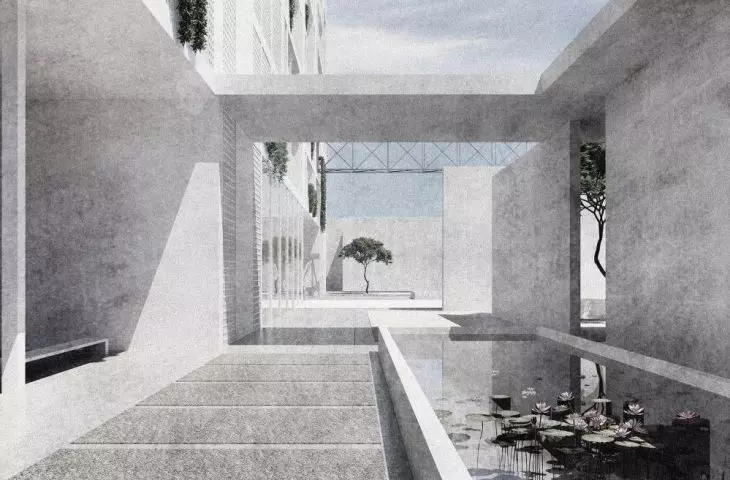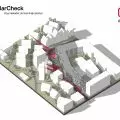A {tag:studenci} from the Faculty of Architecture at Wroclaw University of Technology decided to design an asylum for single mothers with children. The facility, which provides protection and a lost sense of security, would be built on the site of a former freight station in Wroclaw. The author transformed the peaceful area into a place full of greenery, light and friendly spaces. The work was appreciated by the jury of the competition Concrete Architecture 2021, which awarded it the main prize (ex aequo).
The project entitled. "Way station: Asylum for single Mother with Child, Wroclaw" ("Way station: Asylum for single mother with child, Wroclaw") was prepared as a master's thesis under the direction of Dr. Ada Kwiatkowska.
The asylum for single mothers received the Grand Prize in the Concrete Architecture 2021 competition
© Apolonia Slesarow
"How do architecture and cities work for women?" - this question was posed in the 1980s by a feminist group of female architects known as the Matrix. The discussion is still ongoing, and these considerations apply not only to women, but also to other equal users of cities, such as people with disabilities, seniors and children. Among these women, there are also single mothers with children who face problems living and navigating the city, its neighborhoods, and their own homes. They struggle to find their identity as mothers, but also as women. In this selective group of single mothers, we can find women who have experienced violence and who have found the courage to escape from their abusers. Most of them are deeply traumatized, left alone with their children, often rejected even by their families. However, they wish to lead a dignified life and provide such for their children," says Apolonia Slesarow.
An asylum for single mothers could be built on the site of a former freight station
© Apolonia Slesarow
wrocław asylum
The work of a graduate of the Wroclaw University of Technology entitled. "Busstop: Asylum of a single mother with a child, Wroclaw" is an idea whose recipients are single mothers with children and other individuals or families that, according to the author, society perceives as a social margin. The project took the form of an asylum, which is primarily intended to provide protection and a lost sense of security.
The author decided that the facility would, on the one hand, provide privacy and give a sense of isolation from the problems of the outside world, but on the other hand it would also provide opportunities to learn to live in society and integrate with others. Therefore, it was important to her that it be located in the center of Wroclaw. The asylum could be built at the intersection of Pulaski and Malachowski Streets, in the post-railroad area of the former freight station, not far from the planned development estate. The choice of location met the most important assumptions: the possibility of hiding the facility far from the hustle and bustle, while providing easy access to the city center, services and social life.
As the author says: Asylum as a metaphorical "stop" is based on three key ideas:
the idea of a wall, architecture as a garden and architectural haiku
© Apolonia Slesarow
stop
The asylum consists of three structures, each with a different form, height, function and accessibility for outsiders. They are all connected to each other by a wall. The first of the structures is a public building, the next one has workshop functions, and the third one is residential. The author used perforations in the walls of the asylum, so that they would not be perceived as "raw." She filled the openings with 15 cm cubes, which would result in an interesting play of light and shadow throughout the building complex. The entire asylum would have almost 2,500 square meters of floor space and would be surrounded by more than 10,000 square meters of green space in the form of a park and gardens.
The asylum consists of three buildings
© Apolonia Slesarow
"Busstop," a metaphor included in the title, refers to the distinctive context of the extensive railroad infrastructure. The term also underscores the nature of the designed site. The asylum should only be a stopover in the lives of its users. The asylum as a metaphorical "stop" is based on three key ideas: the idea of the wall, architecture as a garden and architectural haiku. The wall is a symbol of security. Its structure in the project changes its character: once it acts only as a wall and a barrier between the outside world and the inner world of the asylum. Then the wall acts as a corridor and passageway, which once is an external path, to immediately change into an internal communication. The wall also transforms into the entire structure of the building and becomes a block. The idea, called "architectural haiku," focuses on details such as the texture of the wall or the movement of light. As in Japanese poetry (haiku), the viewer's attention should focus on only one phenomenon and let him forget about the world around him, the architect explains.
Nature is treated as a therapeutic element in the project
© Apolonia Slesarow
The therapeutic role of greenery
The author treated nature in the project as a therapeutic element and introduced it as architecture as gardening. The idea is to use only individual elements of greenery, which in Asylum are symbolic and emphasized. The whole creates a composition that is based on playing with elements such as light and shadow, varied surfaces, compositional openings and closings. Apolonia filled the interior of the first floor with green elements, which she hid between the free-standing walls. This resulted in a green garden filled with flowers or a winter garden hidden in the "Cave," a space in the first floor of one of the designed buildings. One can find spaces dedicated to individuals and spaces for children and their activities. All, however, are designed to stimulate the perception and emotions of residents.
On the asylum, in addition to apartments, there is also a therapeutic and workshop center
© Apolonia Slesarow
therapeutic and workshop center
The first projected building is an atrium building and is the only one with a fully public character, allowing people from outside the complex to enter and meet the residents. It serves as a therapeutic center offering psychological assistance to all who seek it. The interior is suitable for holding workshops, lectures and seminars. The space acts as a place of integration for all who seek help. The second floor of the building is connected to the wall and the other two structures.
The second building is a pavilion with an amphitheater layout, which allows the free organization of various art workshops. Women living in the asylum could learn new skills that will become their new passion or a way to earn money. The roof of the facility is accessible and allows access to the wall.
The role of light is very important in the project
© Apolonia Slesarov
home for single mothers
The third element of the premise is a residential building for mothers with children, there are also social housing. The first floor of the building was left open by the architect, and she designed three communication risers. The entrance for the tenants of the social apartments is from the outside, on the side of the park. Women, on the other hand, enter the facility from the inside; this space is only accessible to mothers with children.
The building contains both apartments for single mothers and social housing units
© Apolonia Slesarow
Apolonia's main idea was to create a space offering lost privacy that mothers can call "their own." The first and second floors are dedicated to units for single mothers. Each consists of a mother's room and a child's room, as well as a bathroom, a kitchenette and a small utility space. In the middle of the corridor with the apartments would be a laundry room and a common space with a large kitchen. One floor above, the residents would be able to use a meeting room, and from there they could also walk through a corridor to the public building.
The rooftop is a space for neighborhood gatherings, and the first floor is a place for children to play
© Apolonia Slesarow
Levels 3 through 6 were designated for modular social housing. The author designed six modules, two of them as two-levels intended for large or multi-generational families. Each module is equipped with a green loggia. The first floor of the apartment building is a place for mothers and children to meet and play, while the roof has been designated as a place for neighborhood gatherings (of social housing tenants) and growing plants.









































































